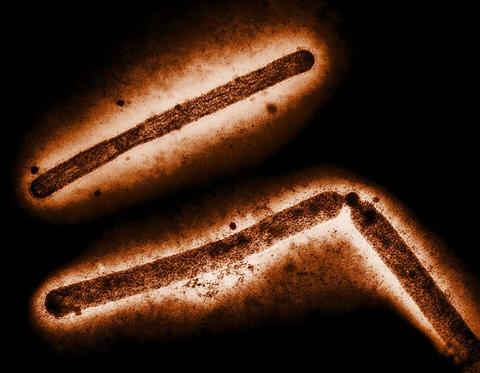A vaccine under development at the University at Buffalo has demonstrated complete protection in mice against a deadly variant of the virus that causes bird flu.

The work, detailed in a study published today (April 17) in the journal Cell Biomaterials, focuses on the H5N1 variant known as 2.3.4.4b, which has caused widespread outbreaks in wild birds and poultry, in addition to infecting dairy cattle, domesticated cats, sea lions and other mammals.
READ MORE: H5N1 influenza viral lineages beginning to evade human immunological defenses
READ MORE: Mutation could facilitate H5N1 bird flu virus infection and potential transmission in humans
In the study, scientists describe a process they’ve developed for creating doses with precise amounts of two key proteins – hemagglutinin (H5) and neuraminidase (N1) – that prompt the body’s immune system to fight bird flu.
This process – what’s known as a “vaccine platform” – could help set the experimental vaccine apart from the handful of bird flu vaccines approved for human use in the U.S. and Europe which, while effective, have focused almost entirely on H5 and not N1.
Evolving strains
It’s also a potential step toward more potent, versatile and easy-to-produce vaccines that public health officials believe will be needed to counteract evolving bird flu strains that grow resistant to existing vaccines.
“We obviously have a lot more work to do, but the results thus far are extremely encouraging,” says the study’s lead author Jonathan Lovell, PhD, professor in the Department of Biomedical Engineering at UB.
Lovell and colleagues tested the vaccine platform in mice with 2.3.4.4b. They used doses containing H5 alone, N1 alone, and H5 and N1 combined. They found that:
- H5 alone provided complete protection, with no signs of illness, weight loss nor detectable virus in the lungs.
- N1 alone gave partial protection. It was roughly 70% effective, with some mice showing symptoms and viral presence.
- H5 and N1 together, which is a bivalent vaccine, also provided complete protection, but it did not outperform H5 alone. Put another way, adding N1 did not offer more protection than H5 alone.
The results, Lovell says, show the important role that H5 plays in developing immunity to bird flu.
Key and scissors
In its viral form, H5 acts like a key allowing the virus to enter and attach itself to host cells where it then starts to replicate. Vaccines with small, safe doses of H5 prompt the body to recognize, remember and destroy the problematic intruder.
N1, meanwhile, acts as an enzyme in its viral form. Like a pair of scissors, it clips residues from the host cell, helping the replicated virus spread throughout the body.
“While they are non-neutralizing, N1 antibodies are still incredibly important. They reduce viral replication and the severity of illness,” Lovell says. “These bivalent formulations could be extremely advantageous as H5N1 evolves.”
Vaccine platform underwent COVID clinical trials
Lovell created the vaccine platform and has been experimenting with it for more than a decade. It consists of tiny spherical sacs called nanoparticles, which are made of cobalt and porphyrin with an outer shell of phospholipid – he calls it “CoPoP” for short.
While not part of this study, the platform underwent phase 2 and phase 3 clinical trials in South Korea and the Philippines as a COVID-19 vaccine candidate. This work was a partnership between UB spinoff company POP Biotechnologies, co-founded by Lovell, and South Korean company EuBiologics.
To create the experimental bird flu vaccine, the researchers added what’s called a histidine tag, or his-tag, to both the H5 and N1. His-tags are short strings of amino acids that have a natural affinity for metals. When mixed with CoPoP nanoparticles, the his-tag proteins form a strong bond with cobalt ions.
“It’s kind of like a magnet attaching itself to a metal surface. It just clicks into place. It’s fast and efficient, which is advantageous when you need to quickly ramp up vaccine production,” says Lovell.
To make the vaccine more potent, the researchers added two immune-boosting adjuvants – QS-21 and a synthetic monophosphoryl lipid A, or MPLA. The adjuvants are mixed into the phospholipid layer.
Easier to produce than egg-based vaccines
The vaccine is what’s known as a recombinant protein vaccine. Unlike currently approved vaccines, which use live or dead versions of H5N1, it relies on bits of genetic material (H5 and N1) from the virus to stimulate immune response.
“Because our vaccine does not require the use of eggs in the manufacturing process – as many influenza vaccines do – it is potentially a faster and more efficient way to protect humans and animals from deadly strains of bird flu,” Lovell says.
The research team plans additional work on the vaccine candidate, including testing different doses, schedules and conditions.
Study co-authors work at the Jacobs School of Medicine and Biomedical Sciences at UB; National Microbiology Laboratory, which is part of the Public Health Agency of Canada; St. Jude Children’s Research Hospital; POP Biotechnologies; National Center for Foreign Animal Disease, which is part of the Canadian Food Inspection Agency; and the University of Manitoba.







No comments yet